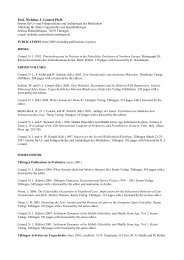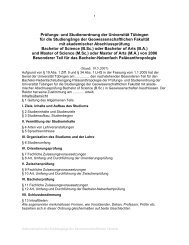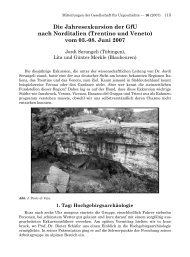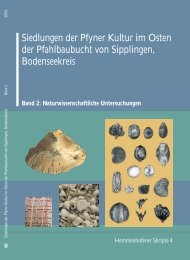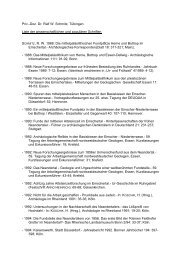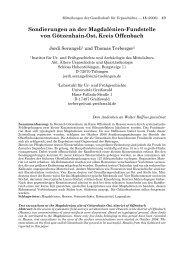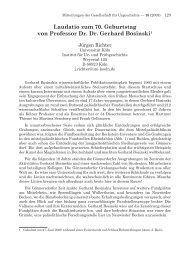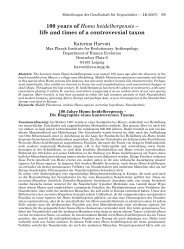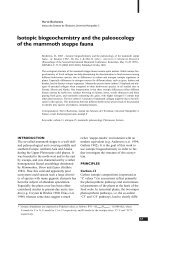bronze age environment and economy in the troad - Universität ...
bronze age environment and economy in the troad - Universität ...
bronze age environment and economy in the troad - Universität ...
You also want an ePaper? Increase the reach of your titles
YUMPU automatically turns print PDFs into web optimized ePapers that Google loves.
chapter 3: analysis<br />
3.2.2.3 Crops <strong>and</strong> weeds dur<strong>in</strong>g <strong>the</strong> different<br />
subperiods of Kumtepe<br />
The species abundance for species classes (ecological habitats)<br />
<strong>in</strong> each sample shows several patterns (Graph 10).<br />
A relationship between <strong>the</strong> subperiods <strong>and</strong> <strong>the</strong> ecological<br />
groups becomes visible. The samples from <strong>the</strong> Neolithic<br />
Kumtepe A have an abundance of seeds of species from<br />
freshwater habitats.<br />
Look<strong>in</strong>g <strong>in</strong> more detail at <strong>the</strong> centre of <strong>the</strong> graph (10, bottom),<br />
we recognise that <strong>in</strong> <strong>the</strong> group of samples from Kumtepe B2<br />
<strong>the</strong> weeds are predom<strong>in</strong>ant <strong>in</strong> terms of seed numbers. The<br />
group of samples from Kumtepe B3 layers is dom<strong>in</strong>ated by<br />
plants from open vegetation (which <strong>in</strong> fact might also be<br />
weeds, but less typical weeds from modern phytosociological<br />
st<strong>and</strong>po<strong>in</strong>t) while <strong>the</strong> abundances of <strong>the</strong> typical weeds are<br />
comparatively low.<br />
This is equivalent to <strong>the</strong> seed abundance for life form classes,<br />
i.e. abundance of typical weeds equates to abundance of<br />
annuals. To summarise, it seems that a decrease <strong>in</strong> weed<br />
abundance took place from Kumtepe B2 to Kumtepe B3.<br />
To get an impression of <strong>the</strong> diversity of <strong>the</strong> weed group that<br />
was most abundant <strong>in</strong> Kumtepe B2 samples <strong>and</strong> less abundant<br />
<strong>in</strong> o<strong>the</strong>r periods or subperiods of Kumtepe, <strong>the</strong> number of<br />
different species for species classes (ecological habitats) was<br />
plotted <strong>in</strong> relation to <strong>the</strong> species abundance (Graph 11). Here<br />
we f<strong>in</strong>d <strong>the</strong> opposite relationship between <strong>the</strong> Kumtepe B2 <strong>and</strong><br />
Kumtepe B3 samples, i.e. <strong>the</strong> Kumtepe B3 samples have a<br />
comparatively broad species spectrum contribut<strong>in</strong>g to <strong>the</strong> weed<br />
class.<br />
To summarise, it seems that an <strong>in</strong>crease <strong>in</strong> <strong>the</strong> number of<br />
typical weed species took place from Kumtepe B2 to Kumtepe<br />
B3, but at <strong>the</strong> same time <strong>the</strong>ir seeds decreased <strong>in</strong> <strong>the</strong>ir<br />
abundance. In <strong>the</strong> subperiod Kumtepe B2 <strong>the</strong> specialised weed<br />
flora should have been a problem for <strong>the</strong> prehistoric farmers,<br />
more than <strong>in</strong> earlier or later periods.<br />
As mentioned, many weed species were most abundant <strong>in</strong><br />
Kumtepe B2 (Graph 10), but many typical weeds (e.g.<br />
Chenopodium album, Eragrostis m<strong>in</strong>or, Fumaria sp.,<br />
Heliotropium europaeum, Polycnemum majus, Valerianella<br />
dentata) were also very abundant <strong>in</strong> subperiod B3. Kumtepe A<br />
samples usually conta<strong>in</strong>ed few species <strong>and</strong> seeds of weeds.<br />
Lathyrus cicera/sativus was very likely <strong>the</strong> accompany<strong>in</strong>g<br />
weed of <strong>the</strong> two abundant crop legumes lentil <strong>and</strong> bitter vetch.<br />
Fig was also numerous <strong>in</strong> rema<strong>in</strong>s dur<strong>in</strong>g Kumtepe A, but also<br />
<strong>in</strong> Kumtepe B3.<br />
Kumtepe B2 samples, which were previously characterised as<br />
conta<strong>in</strong><strong>in</strong>g a lot of weed seeds, conta<strong>in</strong> frequently barley gra<strong>in</strong>,<br />
whereas <strong>the</strong> rachises of barley are most abundant <strong>in</strong> Kumtepe<br />
B3. An almost complete lack of chaff rema<strong>in</strong>s <strong>in</strong> Kumtepe B2<br />
is somewhat surpris<strong>in</strong>g for samples from waste pits. It is more<br />
likely that food rema<strong>in</strong>s (shells, cook<strong>in</strong>g residues) were deposited<br />
here, ra<strong>the</strong>r than rema<strong>in</strong>s from cereal crop-process<strong>in</strong>g.<br />
The most abundant weeds with<strong>in</strong> <strong>the</strong> small species spectrum of<br />
B2 were <strong>the</strong> grasses, <strong>and</strong> amongst those Lolium persicum-type.<br />
Barley was certa<strong>in</strong>ly still an important crop <strong>in</strong> Kumtepe B3,<br />
where <strong>the</strong> rachises were most abundant.<br />
The submerged algae Chara sp. appeared only <strong>in</strong> <strong>the</strong> two latest<br />
subperiods. The purpose of br<strong>in</strong>g<strong>in</strong>g this plant <strong>in</strong>to <strong>the</strong><br />
settlement might have been related to build<strong>in</strong>g, i.e. it might<br />
have come <strong>in</strong> with loamy sediment from pools or similar<br />
freshwater resources, for mudbrick production. It is also of<br />
<strong>in</strong>terest that <strong>in</strong> Kumtepe B3 o<strong>the</strong>r moisture-<strong>in</strong>dicat<strong>in</strong>g plants<br />
were more abundant than before (Cladium mariscus, Scirpus<br />
maritimus, Carex spp.). Vitis v<strong>in</strong>ifera appears already <strong>in</strong><br />
Kumtepe B2, but it is only really abundant <strong>in</strong> Kumtepe B3.<br />
Gra<strong>in</strong>s <strong>and</strong> chaff of both hulled wheats (emmer <strong>and</strong> e<strong>in</strong>korn)<br />
are most abundant <strong>in</strong> Kumtepe B3. It is noticeable that <strong>the</strong>se<br />
cereals are relatively scarce <strong>in</strong> <strong>the</strong> Kumtepe B2 samples, which<br />
raises <strong>the</strong> question of whe<strong>the</strong>r <strong>the</strong>y might have been<br />
contam<strong>in</strong>ants of barley.<br />
To exam<strong>in</strong>e <strong>the</strong> proportions of crops <strong>and</strong> weeds, both <strong>in</strong> <strong>the</strong>ir<br />
abundances <strong>and</strong> <strong>the</strong>ir presence dur<strong>in</strong>g each subperiod,<br />
percent<strong>age</strong> participation <strong>and</strong> presence were plotted.<br />
The percent<strong>age</strong> participation plot of members of <strong>the</strong> crop group<br />
<strong>in</strong> each sample shows that <strong>in</strong> Kumtepe A samples <strong>the</strong> numbers<br />
of crop items are high, <strong>in</strong> Kumtepe B2 samples strik<strong>in</strong>gly low<br />
(Graph 12). The percent<strong>age</strong> participation of members of <strong>the</strong><br />
weed group (typical weeds <strong>in</strong> <strong>the</strong> modern sense) <strong>in</strong> each<br />
sample shows a complementary picture. In Kumtepe B2<br />
samples <strong>the</strong> counts of weeds are relatively high <strong>and</strong> dur<strong>in</strong>g all<br />
<strong>the</strong> o<strong>the</strong>r subperiods comparatively low.<br />
3.2.2.4 Diversity<br />
The presence of crop or weed members <strong>in</strong> different samples <strong>in</strong><br />
addition to percent<strong>age</strong> participation gives an impression of <strong>the</strong><br />
broadness of <strong>the</strong> species spectra (Graph 13).<br />
No clear pattern is visible for <strong>the</strong> species presence of members<br />
of <strong>the</strong> crop group, except that <strong>the</strong> species spectrum of crops is<br />
low <strong>in</strong> Kumtepe A <strong>and</strong> B1.<br />
In <strong>the</strong> case of <strong>the</strong> weeds, <strong>the</strong> patterns are also not very clear.<br />
The species spectrum of typical weeds is relatively narrow <strong>in</strong><br />
Kumtepe A <strong>and</strong> B1 samples, medium <strong>in</strong> Kumtepe B2 <strong>and</strong><br />
broad <strong>in</strong> some samples of Kumtepe B3. The tendency<br />
suggested earlier of a broaden<strong>in</strong>g of <strong>the</strong> weed species spectrum<br />
over time is not reflected very clearly <strong>in</strong> <strong>the</strong> plots. Many<br />
species known from modern weed floras first appear <strong>in</strong> <strong>the</strong><br />
later phases at Kumtepe.<br />
Compar<strong>in</strong>g presence <strong>and</strong> participation for Kumtepe B2, <strong>the</strong><br />
low abundances of <strong>the</strong> crops toge<strong>the</strong>r with a variable species<br />
spectrum are strik<strong>in</strong>g. At <strong>the</strong> same time <strong>the</strong> abundance of<br />
weeds is high only <strong>in</strong> Kumtepe B2 samples, but with a<br />
relatively narrow species spectrum. If <strong>the</strong> high abundance of<br />
<strong>the</strong> few weed species <strong>in</strong> Kumtepe B2 is chronological <strong>and</strong> not<br />
functional <strong>in</strong> nature, <strong>the</strong>n weed <strong>in</strong>festation of fields must have<br />
been severe. The number of samples, however, is too small to<br />
be conclusive, <strong>and</strong> fur<strong>the</strong>r sampl<strong>in</strong>g is strongly suggested.<br />
The number of crop species slightly <strong>in</strong>creases from Kumtepe A<br />
to Kumtepe B (cereals). The weed flora, however, does not<br />
show relative signs of specialisation dur<strong>in</strong>g Kumtepe A (Graph<br />
12 <strong>and</strong> Graph 13). This could be <strong>in</strong>terpreted as evidence of a<br />
different subsistence strategy dur<strong>in</strong>g Kumtepe A, particularly<br />
as seafood was an important means of subsistence. It seems<br />
39





